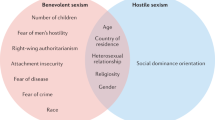Abstract
The aim of this research is toevaluate the evolution of ambivalent sexismtoward women (ASI: Ambivalent Sexism Inventory,Glick and Fiske, 1996) and men (AMI: Acttitudetoward Men Inventory; Glick and Fiske, 1999)with a Spanish sample between 18–65 years ofage (n = 1003). The results show that sexistattitudes toward women and men are conditionedin different ways according to sex and age.Women as well as men have a more hostileattitude towards the opposite sex; but men havebenevolent attitudes toward both men and women.Moreover, there are similarities between thesexes in relation to their benevolent attitudestoward men. It is very interesting to point outthat below the age range of 38–42, there arefewer sexist attitudes and there are significantdifferences between the sexes about sexistattitudes toward women. We conclude that inorder to explain the evolution of sexistattitudes toward men and women, we must takeinto account not only generational changes butalso cultural and historical changes.
Similar content being viewed by others
REFERENCES
Allport, G.W.: 1954, The Nature of prejudice (Reading, MA, Addison-Wesley).
Bailey, W.T.: 1993, ‘College student's attitudes toward abortion’, Journal of Social Behaviour and Personality 8, pp. 749–756.
Expósito, F., M. Moya and P. Glick: 1999, ‘Sexismo ambivalente: medición y correlatos’, Revista de Psicología Social 55, pp. 893–905.
Glick, P. and S. Fiske: 1997, ‘Hostile and benevolent sexism. Measuring ambivalent sexist attitudes toward woman’, Psychology of Women Quarterly 21, pp. 119–135.
Glick, P. and S. Fiske: 2001, ‘An ambivalent aliance. Hostile and benevolent sexism as complementary justification for gender inequality’, American Psychologist 56(2), pp. 109–118.
Glick, P. and S.T. Fiske: 1996, ‘The ambivalent sexism inventory: differentiating hostile and benevolen sexism’, Journal of Personality and Social Psychology 70, pp. 491–512.
Glick, P. and S.T. Fiske: 1999, ‘The ambivalence toward men inventory: differentiating hostile and benevolent beliefs about men’, Psychology of Women Quarterly 23, pp. 519–536.
Glick, P., S.T. Fiske, A. Mladinic, J.L. Saiz, D. Abrams, B. Masser, B. Adetoun, J.E. Osagie, A. Akande, A. Alao, A. Brunner, T.M. Willemensen, K. Chipeta, B. Dardanne, A. Dijksterhuis, D. Wigbouldus, T. Eckes, Y. Six-Materna, F. Expósito, M. Moya, M. Foddy, H.J. Kim, M. Lameiras, M.J. Sotelo, A. Mucchi-Faina, M. Romani, N. Sakalli, B. Udegbe, M. Yamamoto, M. Ui, M.C. Ferreira: 2000, ‘Beyond prejudice as simple antipathy: hostile and benevolent sexism across cultures’, Journal of Personality atad Social Psyohology 79, pp. 763–775.
Helmreich, R.L., J.T. Spence and R.H. Gibson: 1982, ‘Sex role attitudes: 1972–1980’, Personality and Social Psychology Bulletin 8, pp. 656–663.
Jackson, L.: 2001, ‘Contemporary sexism and discrimination: the importance of respect for men and women’, Personality and Social Psychology 23(1), pp. 48–61.
Katz, J., J. Wackenhut and R.G. Hass: 1986, ‘Racial ambivalence. Value duality and behavior’, in J.F. Dovidio and S.L. Gaertner (eds.), Prejudice, Discrimination and Racism (Academic Press, San Diego, pp. 35–59).
Lameiras, F.M. and C.Y. Rodríguez: in press, ‘Validation of ASI and AMI scales in Spanish sample’, Journal of Social Psychology.
Lameiras, F.M., C.Y. Rodríguez and T.M. Sotelo: 2001, ‘Sexism and racism in a Spanish sample of secondary school students’, Social Indicators Research 54(3), pp. 309–328.
Lipovesky, G.: 1999, Woman third (Anagrama, Barcelona).
Rice, T.W. and D.L. Coates: 1996, ‘Gender role attitudes in the southern United States’, Gender and Society 9, pp. 744–756.
Rudman, L.A. and P. Glick: 2001, ‘Prescriptive gender stereotypes and backlash toward agentic women’, Journal of Social Issues 57(4), pp. 743–762.
Sears, D.O.: 1988, ‘Symbolic racism’, in P.A. Katz and D.A. Taylor (eds.), Eliminating Racism (Plenum Press, New York, pp. 53–84).
Spence, J.T. and C.E. Buckner: 2000, ‘Instrumental and expressive traits, trait-stereotypes and sexist attitudes’, Psychology of Women Quaterly 24, pp. 44–62.
Swim, J.K., W.S. Aikin, W.S. HaII and B.A. Hunter: 1995, ‘Sexism and racism: old-fashioned and modern prejudices’, Journal of Personality and Social Psychology 68(2), pp. 199–214.
Tougas, F., R. Brown, A.M. Beaton and S. Joly: 1995, ‘Neosexism. Plus ça change, plus c'est pariel’, Personality and Social Psychology Bulletin 21, pp. 842–849.
Twenge, J.M.: 1997, ‘Changes in masculine and feminine traits over time: a meta-analysis’, Sex Roles 36(5/6), pp. 305–325.
Twenge, J.M. and A.N. Zucker: 1999, ‘What is a feminist? Evaluations and stereotypes in closed and opend ended responses’, Psychology of Women Quarterly 23, pp. 591–605.
Author information
Authors and Affiliations
Rights and permissions
About this article
Cite this article
Fernández, M.L., Castro, Y.R. & Lorenzo, M.G. Evolution of hostile sexism and benevolent sexism in a spanish sample. Social Indicators Research 66, 197–211 (2004). https://doi.org/10.1023/B:SOCI.0000003553.30419.f1
Issue Date:
DOI: https://doi.org/10.1023/B:SOCI.0000003553.30419.f1




